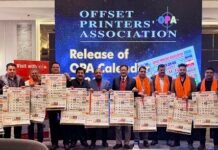
SwissQprint has launched the fifth generation of its wide format UV LED flatbed printers, with a significant boost in their overall productivity. The new platform includes both the Impala 5, with its 2.5×2 meter wide bed, and the larger Nyala 5, with a 3.2×2 meter wide bed but not the entry level Oryx. It represents far more than an incremental upgrade as these new models are based on the much beefier Kudu platform that was introduced in 2022. Carmen Eicher, chief sales and marketing officer for SwissQprint, says, “The Kudu has been very well received by our customers and we have installed more than 100 machines worldwide.”
The new generation continues SwissQ’s long association with Konica Minolta printheads, and will use the same Q1280i heads as the existing fourth generation models and the Kudu. Thus the printers can achieve 1350 x 1350 dpi resolution.
The new Impala is now 26% faster than the previous model, with its maximum speed up from 180 to 227 square meters an hour. The Nyala 5 sees an increase from 206 to 253 square meters an hour. As before, the standard machines come with a single row of printheads, with one head per color channel, but can be configured with a second row of heads for faster productivity, to produce these maximum speeds. Eicher emphasizes that the maximum speeds quoted will produce sellable print quality, “We have many customers who run their machines at these speeds for some jobs.”
This speed increase is mainly down to the use of linear drives, which accelerate and decelerate much faster than a belt-driven system, and this is backed up by a much stronger beam. The result should be more accurate placement of each individual ink drop at higher speeds, allowing for higher print resolution with fewer passes.
The new platform means that the number of color channels goes up from nine to 10. This allows for a typical configuration of CMYK plus light cyan and light magenta, neon pink, neon yellow, plus white and varnish. Other options can include a primer and orange. (SwissQ has also offered violet and green but found that these colors did not expand the color gamut enough to be worth using.)
Eicher says that most customers do take advantage of these channels, with 94% opting for white and 70 % taking varnish. She adds, “And the varnish ink usage is quite high so our customers really see the benefit of varnish and use it a lot.” The inks themselves seem to be the same inks from the existing suppliers in the UK and South Africa.
SwissQprint previously addressed the need for higher speeds by introducing ’S’ variants for the Impala and Nyala, loaded with two sets of CMYK plus an option for one other color to dramatically increase the productivity. However, there will be no ’S’ versions of the new machines, even though the 4S models are faster than the new generation 5. This is because SwissQ believes that the combination of the ten color channels and higher speeds of the new models will be a better fit for most customers.
Meanwhile the Kudu has also benefited from a small increase in its maximum speed from 302 to 341 square meters an hour, mainly achieved by improving some of the internal electronics. This means that the main difference between the Nyala and the Kudu is the number of printheads as the Kudu can be configured with a third row of heads for a total of 30 heads. Despite having a similar chassis, there’s no way to upgrade the Nyala to the Kudu spec as there are too many elements that would need to be changed.
However Eicher says that SwissQ will help customers upgrade by taking back an existing machine, refurbishing it to factory spec and reselling it. This gives existing customers an incentive to upgrade and also offers new customers a cost-effective way to buy one of these machines. The SwissQ machines do have an extremely good reputation for reliability and longevity and the company is now offering a 36 month warranty to emphasize this.
SwissQ has also taken the opportunity to switch the flatbeds to its Lory software, which it originally developed for the Karibu rollfed range. Essentially it’s a more visual system than the older software with more automation features. This software will also be offered in the future to existing customers with the generation 4 machines.
Rollfed, Collector Paper and Oversize Board options
Naturally SwissQ will continue to offer a rollfed option for its flatbeds with Adriano Gut, key account manager for SwissQprint, saying that 75% of customers take this option. It’s a sensible option to have with a flatbed as it allows an extra set of jobs to be printed overnight. The standard roll feeder will take media up to 180 kilgrams in weight – up to 2.5 meters wide on the Impala and 3.2 meters wide on the Nyala.
There’s also a Dual roll option that uses two different shafts so that you could run two different rolls side by side, each up to 1200 mm for the Impala or 1550 mm wide for the Nyala, and up to 50 kilograms in weight. However, the two rolls do have to be the same type of media as the beam movements have to be the same for both.
SwissQ has also renamed the Glass option as the Collector Paper option. Essentially this makes use of the roll-fed option to hold a sacrificial paper over the flatbed but underneath a substrate. This allows for edge to edge printing with the excess ink landing on the paper rather than the bed itself. It allows the vacuum bed to work as normal but does cover up the holes needed for the registration pins. To get around this, it includes an alignment edge.
Other options include the Oversize Board option that will take boards up to 4 meters long. Essentially this adds tables either side plus a conveyor mechanism to move the boards through the printer.
There’s no word on pricing for the new machines, though Eicher promised that customers would only see a small percentage increase over the existing models. Customers will have to judge for themselves if the benefits justify the cost but the speed increase alone should allow most users to recoup the additional outlay.
SwissQ chose not to mention its roll-to-roll machine, the Karibu, but it seems to me only a matter of time before this too gets an upgrade. After all, Karibu customers would probably also like to have ten color channels for the same reason as with the flatbeds, so that they can use both the neon colors alongside the other options. And, of course, everybody always wants more productivity.
The new models are available immediately with some already installed, including one at a customer site in the UK and a second for demos at SwissQprint UK’s offices. You can find further information and specifications for the fifth generation Nyala and Impala from swissqprint.com.
First published in the Printing and Manufacturing Journal on 13 January 2025. Reprinted by permission www.nessancleary.co.uk
















